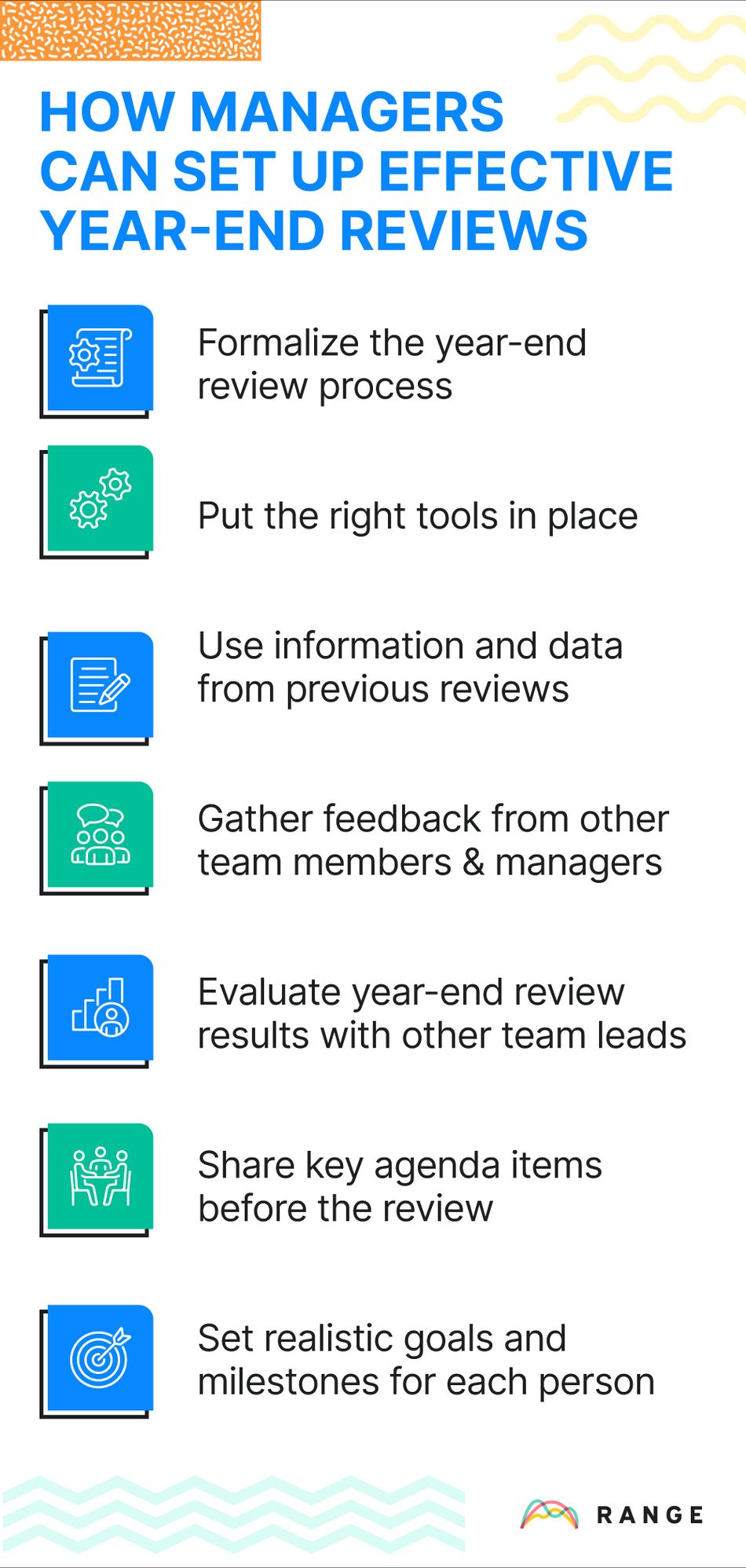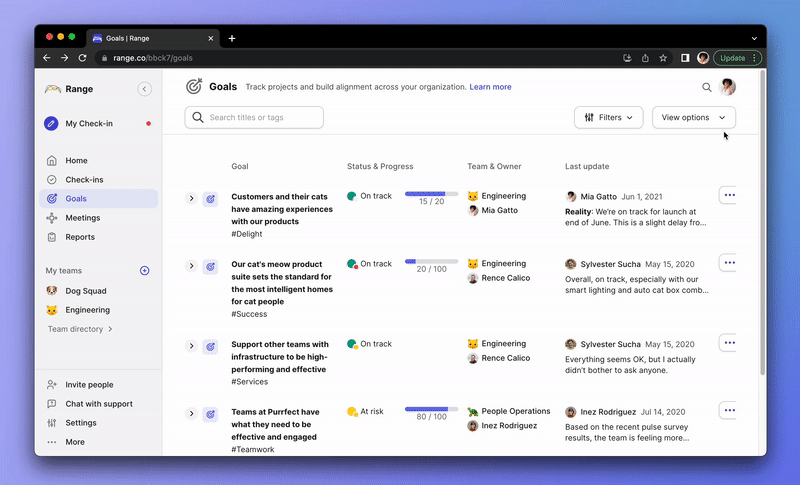If you’re like most people, participating in a year-end review isn’t on your top 10 favorite work activities. Yet this activity can be vitally important for team members, serving as the basis for advancement and raises. It’s also a powerful tool for managers who want to help their teams grow.
Join us as we explore strategies and tips for nailing your year-end review, whether you’re a manager leading them or a team member participating in one.
Let’s get started with why year-end reviews matter, and why companies invest so much time and effort into them.
Why are year-end reviews so important?
The year-end review is a time when managers can evaluate the accomplishments of their team members as well as progress toward established goals.
For the manager, the annual performance review is a prime coaching and feedback opportunity (though it certainly shouldn’t be the only one!). For the team member, the year-end review should be a time to learn more about their performance and gain strategies for continuous improvement. Year-end reviews are valuable because they embody the following three important criteria:
A great time to discuss accomplishments from the previous year
Often in the midst of doing the work, team members can lose sight of their own progress or accomplishments throughout the year. And, unfortunately, many department leaders struggle to celebrate success or accomplishments as often as they should.
While the employee performance review shouldn’t be the only time your team members receive praise, this meeting provides a dedicated slot on the calendar to discuss these things.
A place for open feedback and discussions about improvement areas
No matter how stellar your team members are, everyone has weaknesses and blind spots. Again, we certainly don’t recommend saving all conversations about improvement for a once-a-year review. But the review is the perfect place to give focused constructive feedback about where an individual needs to improve.
Depending on your structure and company culture, this can be a two-way street, where you invite employees to give you feedback on where you can improve yourself. If you’re an employee reading this and you shiver at the idea of critiquing your boss — even when asked — then you might benefit from HBR’s take on the right way to give manager feedback.
An opportunity to review compensation and benefits
At most organizations, the year-end review is also the main time when managers and team members review compensation and benefits. Merit- or performance-based raises should be tied to the feedback you’re already discussing.
Depending on your company culture, employees may be unsure or confused about when to start a discussion on compensation or about a promotion to the next level. Managers should consider making it clear to teammates that this is a welcome time for such conversations.

Common year-end review mistakes and how to avoid them
Year-end reviews are a vital part of most businesses' performance management. But to get the most out of these reviews, managers (and team members) need to come prepared with a clear plan of action.
We’ve collected four common mistakes managers make when year-end performance review time rolls around. Be aware of these pitfalls, and if you recognize one of them in yourself, make sure to check out the solutions we’ve provided for each one.
1. Highlighting too many (or the wrong types of) negative elements
First, managers sometimes have a long list of deficiencies they would like a team member to work on, and it’s tempting to unload absolutely everything at once.
But this approach can quickly overwhelm your team members, who may feel that improvement is hopeless or a lost cause.
Another similar mistake is highlighting negative traits about the person rather than negative results from their behavior. Describing someone as lazy or rude or unreliable rarely leads to acceptance and change.
What to do instead
No matter how long the list of flaws for a given team member, try to limit your negative employee feedback or constructive criticism to just a few (perhaps two) areas. Team members should feel empowered and focused on what to change rather than overwhelmed.
And as far as focusing on traits, just about any negative trait can be recast as a problem in the work. Instead of laziness or unreliability, focus on consistently late or low-quality work. Instead of rudeness, focus on specific actions or outcomes (for example, “When you spoke in that way to Vanesa, the team no longer felt willing to share ideas”).
2. Discussing and comparing team members to their peers
The performance review isn’t a tournament-style competition, so managers should avoid peer-to-peer comparisons wherever possible. This is especially important when discussing intangible or subjective qualities. It may be true that Rich produces more widgets than Gabrielle, but avoid describing Rich as nicer or faster or better when you conduct Gabrielle’s end-of-year review.
What to do instead
Do what you can to keep things objective, not tied to “the competition” within the department. People tend to be less offended when you push them to simply attain more or reach a defined standard than when you suggest they just need to be more like someone else.
3. Waiting for year-end reviews for important discussions
Practically no one likes conflict. So many managers shy away from bringing up difficult subjects with their direct reports. Instead of tackling performance issues as they arise and problem-solving them with the team member, some managers save those important conversations for the year-end review.
But the performance review process isn’t designed to be a catalog of all the failures and issues of the last year. Many issues can become habits in far less than a year’s time, and team members will lose respect for managers who noticed something in March of last year and don’t bring it up until the new year.
In investigating why performance evaluations sometimes fall short of their goals, Gallup highlights the lack of manager communication throughout the year. The group finds some alarming results: Nearly half of employees report receiving manager feedback just a few times per year, or even less. No wonder they feel frustrated at the performance review!
What to do instead
If at all possible, start holding regular one-on-one meetings with each member of your team. This way, you get into a pattern of regular communication and can address issues before they fester into big problems or grow into habits.
Not sure where to start with one-on-ones or with year-end appraisals? Check out The Meeting Manual, Range’s comprehensive guide to running effective meetings (in person, virtual, and even asynchronous).
4. Making general statements that need more explanation
Good feedback is as specific as possible (without veering into any of the other common problems, like comparing people). But being specific can feel aggressive or awkward for many managers, so they tend to generalize their constructive criticism. But if you get too general, your direct reports won’t know what you’re trying to get them to fix.
Vague, general feedback is frustrating for your team members — and it doesn’t lead to the growth outcomes you want to see.
What to do instead
Giving specific, actionable feedback is key. Yes, this will feel uncomfortable, especially if you’re a conflict-averse leader. But your best employees, the ones who truly care about their career development and professional growth, will take your specific feedback to heart and then seek to change and improve.
Where you can, provide specific examples of the negative element, or point out which metrics your team member could use to measure growth.
How managers can set up effective year-end reviews
Avoiding common pitfalls is a start, but if you’re a manager, you don’t just want to conduct not-bad performance reviews. You want to conduct extremely effective ones.
Check out this list of management best practices for year-end reviews. Do a little self-evaluation here, and if you’re missing some of these practices, add in one or two of these next month or next year (whenever it’s review time again).
1. Formalize the year-end review process as much as possible
We know, businesses don’t usually want to be more formal and stuffy, but the performance review process is one place where structure and formality create major value.
If your performance reviews involve changes to compensation, not being standardized in how you conduct them is a big red flag that could even create legal or human resources trouble.
Even if you aren’t worried about legal ramifications, relying on a form, script, or template is a great way to keep yourself on track and avoid off-the-cuff remarks. Of course, you should modify any template you find to fit the specifics of your business and department.
2. Put the right tools in place
You don’t want to jump into performance evaluations without setting up systems and implementing digital tools, so take time now to prepare for how you’ll conduct reviews in the upcoming year.
In addition to a good template, you’ll want some kind of tool for tracking performance all year long. Remote and hybrid teams can face additional hurdles here — as awkward as in-person performance reviews can be, doing them over Zoom can be even worse.
Range is a smart team communication tool to implement prior to performance reviews, especially for remote and hybrid teams. Having a centralized place for video meetings, check-ins, chat, and asynchronous comms will make it far easier to give that regular feedback that feeds a healthier and more productive annual performance review.
Check out Range now to see what it can do for your communication and teamwork.
3. Use information and data from previous year-end reviews
If you’re tracking progress over time, leverage the data you have. (And if you aren’t tracking any metrics in an organized way, now’s the time to start.)
All team members other than the newest ones aren’t starting from scratch or without context. You know how well they progressed over previous years, which is important when considering relative progress over the past year.
4. Gather feedback from relevant team members and managers
As hard as you try, sometimes it isn’t possible to have a complete picture of every single direct report. Especially if you’re managing many remote workers, getting that sense for how they’re doing can be more challenging. You don’t see coworkers’ body language (negative or positive) or the apparent emotional state of team members like you would when they walk by your office every day.
Don’t go it alone: When you need to, gather feedback from team members that work closely with the individual as well as other managers that have some contact.
5. Evaluate year-end review results with other team leaders
Speaking of your fellow managers, you may find it helpful to connect with each other to evaluate year-end review results. The measurements and scale of these reviews can be pretty subjective, so you might want to make adjustments based on how high or low your peers are scoring their team members.
6. Share key agenda items before the review
Good performance reviews aren’t one-way lectures — they’re legitimate two-way discussions. But to be prepared, your team members need to know what you plan to talk about. Share a meeting agenda ahead of time, including (where possible) the areas you plan to highlight.
7. Set realistic goals and milestones for each individual
Actionable outcomes are just as important as clear critiques during performance appraisals. It doesn’t help a person much to know about a problem that they don’t know how to fix.
Give each team member clear, attainable goals to strive for, along with milestones that indicate progress toward those goals.
How team members can ace their year-end reviews
We’ve covered manager tips and strategies thoroughly now, but what about individual team members?
If you’re a worker preparing for an upcoming year-end review, implement these strategies so you can get the most out of the performance review meeting.
Come prepared by completing any action items
If your manager assigns any pre-work before the review, you absolutely must do that work. Your manager might ask you to set goals, list competencies, or evaluate your overall performance with a self-assessment. Walking into a performance review without this assigned work is a pretty bad look.
Bring constructive feedback about yourself
Most of the time, you already have a sense of some of what you need to work on. Think through the areas where you know you could improve, and maybe even what ways you’ve thought about making it happen.
Offer individual or team-wide suggestions
Ideally, you’ll have separate regular check-ins with your manager (such as one-on-ones) where you can make suggestions for broader improvement within your department or team. But your performance review is another more focused opportunity to do so. Your boss may ask you for this feedback, so think through what you want to say (and how to say it appropriately, kindly, and constructively).
Discuss job-related challenges and how you overcame them
You want to describe yourself in a positive way where possible, especially if you plan to negotiate a raise during the review. Before your review, think through your best accomplishments and how you overcame challenges on the job over the past year. Be ready to brag on yourself a little, especially if you’ve had some major wins that your boss might not know about.
Ask for feedback and receive it respectfully
Approaching your performance evaluation with a dose of humility says a lot about your level of professionalism (and a great way to get your boss’s attention). Don’t wait for your boss to lay the negatives on you — ask for that feedback and demonstrate thanks for receiving it.
Keep it professional and positive
Taking criticism is hard, and let’s be honest: Your manager might not even do a good job sharing it. Whatever happens (within reason), keep control of your own responses. Staying professional and looking for positive ways to grow and move forward is a great way to grow (and to get noticed).
How Range helps your year-end review
Don’t be surprised by your performance review. Use Range to share check-ins and goals with Range.

- Create accountability by sharing information and updates across the team
- Easily track how daily work connects to higher-level goals
- Set a goal for metrics, objectives, and KPIs
- With hashtags, see all artifacts, updates, and day-to-day progress in one place
- Share goal updates with leaders via Slack or email
- Connect daily work from 75+ tools to top-level goals








